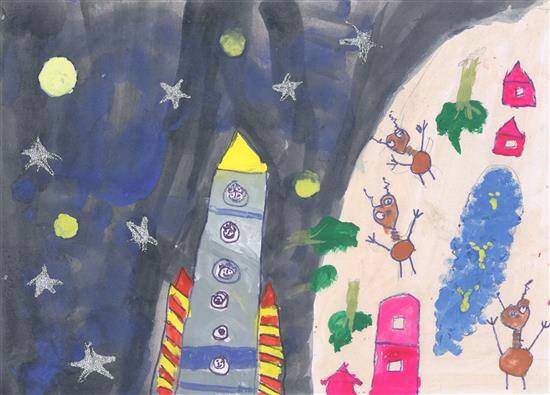Outer Space
 Outer space, or just space, is the void that exists between celestial bodies, including Earth. It is not completely empty, but consists of a hard vacuum containing a low density of particles, predominantly a plasma of hydrogen and helium as well as electromagnetic radiation, magnetic fields, neutrinos, dust, and cosmic rays. Plasma with a number density of less than one hydrogen atom per cubic metre and a temperature of millions of kelvins in the space between galaxies accounts for most of the baryonic (ordinary) matter in outer space; local concentrations have condensed into stars and galaxies. In most galaxies, observations provide evidence that 90% of the mass is in an unknown form, called dark matter, which interacts with other matter through gravitational but not electromagnetic forces. Data indicates that the majority of the mass-energy in the observable universe is a poorly understood vacuum energy of space which astronomers label dark energy. Intergalactic space takes up most of the volume of the Universe, but even galaxies and star systems consist almost entirely of empty space.
Outer space, or just space, is the void that exists between celestial bodies, including Earth. It is not completely empty, but consists of a hard vacuum containing a low density of particles, predominantly a plasma of hydrogen and helium as well as electromagnetic radiation, magnetic fields, neutrinos, dust, and cosmic rays. Plasma with a number density of less than one hydrogen atom per cubic metre and a temperature of millions of kelvins in the space between galaxies accounts for most of the baryonic (ordinary) matter in outer space; local concentrations have condensed into stars and galaxies. In most galaxies, observations provide evidence that 90% of the mass is in an unknown form, called dark matter, which interacts with other matter through gravitational but not electromagnetic forces. Data indicates that the majority of the mass-energy in the observable universe is a poorly understood vacuum energy of space which astronomers label dark energy. Intergalactic space takes up most of the volume of the Universe, but even galaxies and star systems consist almost entirely of empty space.
There is no firm boundary where outer space starts. However the Kármán line, at an altitude of 100 km (62 mi) above sea level, is conventionally used as the start of outer space in space treaties and for aerospace records keeping. The framework for international space law was established by the Outer Space Treaty, which entered into force on 10 October 1967. This treaty precludes any claims of national sovereignty and permits all states to freely explore outer space. Despite the drafting of UN resolutions for the peaceful uses of outer space, anti-satellite weapons have been tested in Earth orbit.
Humans began the physical exploration of space during the 20th century with the advent of high-altitude balloon flights, followed by manned rocket launches. Earth orbit was first achieved by Yuri Gagarin of the Soviet Union in 1961 and unmanned spacecraft have since reached all of the known planets in the Solar System. Due to the high cost of getting into space, manned spaceflight has been limited to low Earth orbit and the Moon.
Outer space represents a challenging environment for human exploration because of the dual hazards of vacuum and radiation. Microgravity also has a negative effect on human physiology that causes both muscle atrophy and bone loss. In addition to these health and environmental issues, the economic cost of putting objects, including humans, into space is very high.
(source : Wikipedia)